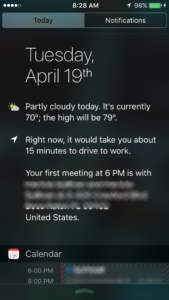Waze should have laughed at me.
The privacy-aware side of me was a bit freaked out the first time my phone decided to let me know that if I left for work right now I’d probably be on time.

It knew, though it didn’t know why, that I tended to do a weird morning routine. Loop through the school parking lot at 7:10, drive to the grocery store at 7:15 and park, do a loop-de-loop around the school parking lot again at 8:10, before finally heading into work by 9:00. Fuh-reak-y.
But carrying around a cell phone is a walking, talking, data-collecting elephant to begin with. What’s a little more data? That useful part of it makes the data and usability nerd in me happy.
Hyper-Realtime Traffic Info
I got to thinking about the head to head race I had this Easter Sunday. I was thinking about it as I was running errands at lunch, my usual use of that hour. Did I have time, I asked Waze, to skedaddle west eight miles and south ten miles to pick up paperwork from a medical office?
Waze assured me in it’s non-judgemental way that I’d be held up by rail crossing closures and heavy lunch time traffic. And, oh yeah, a huge festival (one of what, 50 this year?) that had a major arterial road blocked off for at least half a mile. I might make it ….
What it didn’t tell me, but I remembered in time, is that the office closes every day for lunch. I put that errand off for another day.
But what if Waze was hooked into NAP data, too?
I gave Waze the address of the place I wanted to go by sending it information I dug by hand from my contacts list. But what if I were able to send that info automatically? And put hours into my contact information for someone? Say, that the office opens at 9am and closes from 12:30 to 1:45 for lunch? We could Waze could read that, too, and then laugh at me tell me I was attempting a fool’s errand.
Or even better; if Waze was hooked into Google’s NAP data, with open and shut times? I wonder if it even supports “siesta” times? It’d be darn helpful if it did.